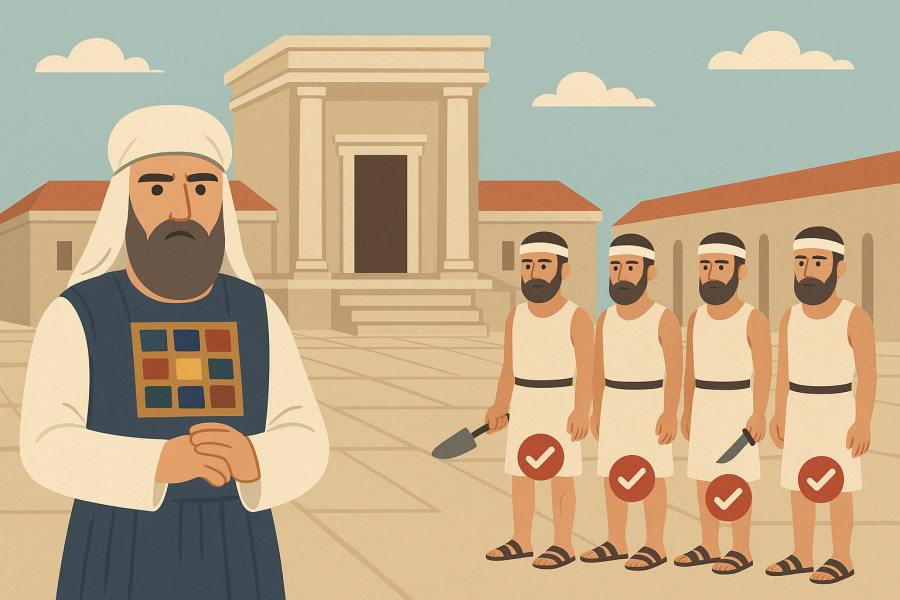Temple Tales: Misinterpreting Ezekiel’s Curious Temple Vision
As we enter the time of Passover, it's fitting to reflect on one of the most misunderstood visions in all of scripture—Ezekiel’s temple vision in chapters 40 through 48. This detailed prophetic passage has stirred centuries of debate, assumptions, and doctrinal confusion. Let’s clear the fog and take a deeper look.
Who Was Ezekiel?
-
Hebrew name: Yechezkel, meaning "God strengthens"
-
Fourth of the five major prophets (Isaiah to Daniel)
-
Exiled to Babylon in 597 BC
-
Began his prophetic ministry at age 30 (circa 592 BC)
-
Prophesied for nearly 25 years
-
Married; his wife’s death served as a sign from God (Ezekiel 24:18)
What Did Ezekiel See? A Unique Temple Vision
In the final nine chapters of his book, Ezekiel sees an elaborate vision of a future land and temple. But this temple differs significantly from Solomon’s temple or the tabernacle in the wilderness.
Notable Absences in Ezekiel’s Temple
-
No court for women
-
No wall separating Gentiles
-
No lampstand, altar of incense, veil, or ark of the covenant
-
No mention of gold or silver
-
No Feast of Firstfruits, Pentecost, Day of Atonement, or Trumpets
-
Only Passover and Tabernacles are mentioned
Despite these differences, Ezekiel never explicitly prohibits other feasts—he just doesn’t mention them.
Sacrificial Differences
-
Daily sacrifices differ from Mosaic law (see Numbers 28)
-
Cutting and preparation of sacrifices falls to the congregation, not priests
-
“Meat offering” refers to grain, not flesh KJV
4 Common Misconceptions about Ezekiel’s Temple
Let’s break down four key misconceptions that plague popular interpretation:
1. "The Temple Is in Jerusalem" – False
-
Biblical Evidence: Ezekiel 48 repeatedly refers to “the city” (ir), which is about 3 miles south of the temple.
-
Commentaries Agree: Lang and Carroll both emphasize this spatial separation.
-
Conclusion: This is not the Jerusalem Temple—it is north of the city, near Shiloh or Mount Gerizim.
2. "It’s Located in Jerusalem" – False
-
The tribal divisions in Ezekiel 48 place the sacred land (called the Terumah or sacred offering) in northern Canaan, not ancient Jerusalem.
-
The temple's position aligns with Shiloh, the place where God first caused His name to dwell (Jeremiah 7:12).
3. "It’s the Millennial Temple" – False
-
Isaiah 11 paints a peaceful Millennial Kingdom: wolves with lambs, no killing, abundant peace.
-
Ezekiel’s vision involves animal sacrifices, physical boundaries, and heavy population density—completely inconsistent with Isaiah, Joel, or Revelation.
Population Comparison
-
Ezekiel’s land offers just 27 square miles per tribe.
-
That’s a staggering 37,000 people per square mile, denser than New York City.
-
If literal, you’d need to fit 600 people in one average home—plus lions and snakes (Isaiah 11)!
-
Clearly, this is not the Millennial paradise.
4. "There’s a Physical Temple in the New Jerusalem" – False
-
Revelation 21:22 says, “I saw no temple therein: for the Lord God Almighty and the Lamb are the temple of it.”
-
In the Millennium, we worship in spirit and truth, not blood sacrifice or stone temples.
So What Was Ezekiel’s Temple?
This vision was conditional—a divine offer to the exiled Israelites if they repented. Had they turned from sin, God would have restored them fully to the land, given them a new temple, and dwelled among them.
But they did not repent.
Only a Remnant Returned
-
Ezra 2:64 says only 42,560 returned from Babylon—a fraction of the tribes.
-
Jeremiah 3:14 foretold it would only be “one of a city, two of a family.”
-
Isaiah named his son Shear-Jashub meaning “a remnant shall return.”
The Temple Now Is Not of Stone, But of Spirit
The New Testament is clear: we are the temple.
“Ye also, as lively stones, are built up a spiritual house...”
—1 Peter 2:5
“Know ye not that ye are the temple of God...”
—1 Corinthians 3:16
We worship not in Jerusalem nor Mount Gerizim but “in spirit and in truth” (John 4:21–24). Animal sacrifices are over. We now offer sacrifices of praise (Hebrews 13:15).
Conclusion: A Vision Unfulfilled
Ezekiel’s temple was never built. Not because God failed, but because the people did.
This vision:
-
Was not located in Jerusalem
-
Was not millennial
-
Described a conditional promise to a disobedient people
-
Does not match the glorious city described in Revelation
Let Us Be the Temple
Rather than await a new building of stone, let us be built up as a temple for His Spirit. The real fulfillment of Ezekiel’s prophecy is spiritual—and eternal.
“The tabernacle of God is with men... and I saw no temple therein...”
—Revelation 21:3, 22
Amen and amen.
#ezekiel #heaven #christian #conduct #desciples #endTimes #endureToEnd #lastDays #messiah2030 #messiah2033 #messsiah2028 #practices #prophecy #sabbath #spiritual #theElect #TheGreatTribulation
